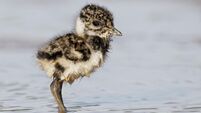Autumn brings some unwanted house guests — spiders are fully loaded and looking for love

You can identify male house spiders by their large ‘palps’ — little clubs — at the top of the head. Before he sets out to look for a mate, he spins a small web, on which he deposits a drop of sperm, and loads it onto his palps and then he’s off, fully loaded, looking for a girlfriend.
Out of the corner of my eye, I notice a blurry, fast-moving, dark brown creature scurrying across the floor. For a second, I thought it was a house mouse, it was so big. But no, it pauses before hiding under an armchair and I see it is just a rather large house spider.
Phew! A lot of people don’t like spiders, but they’re much easier to deal with than catching a house mouse.
It can seem like giant spiders are invading your home at this time of year, but they may have already been there and they’re just more obvious now. Male house spiders mature in early autumn, so they’re more active, as they’re out and about looking for the ladies.
House spiders, with their eight long legs and hairy bodies, enter houses in autumn for shelter and mating opportunities. It’s when they fall into sinks or baths and become trapped or you turn on the light in a dark room that their cover is blown.
If you want to take a close look – especially if one is trapped against white porcelain, you can identify the males by their large ‘palps’ — little clubs — at the top of the head. Before he sets out to look for a mate, he spins a small web, on which he deposits a drop of sperm, and loads it onto his palps and then he’s off, fully loaded, looking for a girlfriend.

Females are larger creatures that form large grey webs – often in the corners of sheds or garages. She can survive here for two years, spending most of her time in a tunnel in the centre of the web, four of her legs on the web to sense any movement, which prompts her to rush out to ambush prey.
The old saying 'If you wish to live and thrive, let a spider run alive' probably originated from the knowledge that keeping flies and other pests at bay is a good thing for human health. But I do usually catch and release them outdoors because someone in the house has pretty extreme arachnophobia.
Autumn is also the time of year for the annual emergence of daddy-long-legs. These long-legged creatures are insects — not spiders as is sometimes thought. Of course, they have only six legs and long thin wings.
They sometimes end up inside your house by accident, attracted by light through windows or doors, but don’t cause any damage and are completely harmless.
There is a long-standing urban myth that the daddy-long-legs has the most potent venom but that their mouth parts are too weak to pierce anything as strong as human skin. I think it was Ricky Gervais who started or at least helped to spread this rumour during one of his stand-up tours on animals.
Confusion may have arisen with spiders because in the US, there is a spider that is often called ‘Daddy-long-legs, and it does subdue and eat venomous spiders. But our daddy-long-legs is a ‘Crane Fly’ — a type of large fly.
They aren’t difficult to spot once they blunder into your house as they are clumsy fliers — crashing around a room, like a drunk helicopter pilot. They bounce off lights, ceilings, walls and windows with no grace and what seems like little control.
If you want to catch and release a Crane Fly, you have to be careful to grab the whole creature in your fist, so as not to accidentally amputate a delicate ‘deciduous’ leg. The Crane Fly has evolved this ability so that if they are caught by a predator or in a spider’s web, they can easily sacrifice a leg or two to escape.

They may not look like elegant fliers, but they can ride on air thermals to get high and far, and their outspread legs act like a parachute.
The Crane Fly actually spends most of its life underground as a larva we call a ‘leatherjacket’, feeding on grass roots. Leatherjackets are about 3cm long and spend about 10 months feeding voraciously underground. The eggs/leatherjackets are an important food source for many birds, who pierce the ground to find them, aerating the soil.
Then, around September, the leatherjacket transforms into its adult flying stage and they emerge en masse from lawns. It will only survive up to two weeks as a flying adult and won’t feed at all in this time. It may land on a flower to drink some nectar, but its mouth parts are very poorly developed so they are incapable of biting anything.
Adult Crane Fly have just one mission — to mate and lay eggs in the soil to ensure the next generation.
So if you notice more spiders or Crane Fly visitors, perhaps you can take pity on them and redirect them back outdoors. They’re just like excited teenagers looking for a date.










